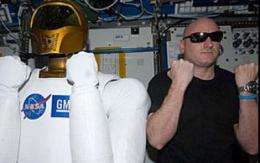NSF leads interagency collaboration to develop advanced robotics

The National Science Foundation (NSF) will take the lead with three other federal government agencies to support the administration's National Robotics Initiative (NRI) and released a solicitation for proposals today.
NRI complements the Obama administration's Advanced Manufacturing Initiative and technology transfer efforts and supports the development and use of robots in the United States that work beside, or cooperatively, with people and that enhance individual human capabilities, performance and safety.
"It's exciting to be on the forefront of creating new knowledge and to play a catalytic role in the development of smart technology that enhances America's productivity and ultimately the quality of life of Americans," said NSF Director Subra Suresh. "It's also an opportunity to harness the expertise of our colleagues in several government agencies to tackle a major challenge and to bolster creative science and the U.S. economy. NSF is proud to lead this effort."
As per the initiative, NSF, along with the National Aeronautics and Space Administration (NASA), the National Institutes of Health (NIH) and the United States Department of Agriculture (USDA) will advance the science and engineering of co-robotic systems that safely co-exist in close proximity to humans in the pursuit of mundane, dangerous, precise or expensive tasks.
Over the past five years, tremendous advances in robotic technologies have made possible a new generation of assistive systems and devices in industries as diverse as manufacturing, logistics, medicine, healthcare, agriculture and consumer products.
For example, state-of-the-art technology systems, such as the Intuitive Surgical daVinci robot, are already beginning to assist doctors with complex surgical procedures. The Independence Technology iBot safely propels wheelchairs over curbs and up stairs, and systems like Cyberdyne's HAL augment body movement and strength for construction workers with wearable robot exoskeletons.
With the help of NRI, the functioning and performance of such systems will be multiplied by combining them with machine intelligence and wireless networks.
"The primary purpose of this cross-agency initiative is to provide US leadership in science and engineering research and education aimed at the development of the next generation robotics, " said Farnam Jahanian, NSF's Assistant Director for the Computer and Information Science and Engineering (CISE) Directorate. "We have barely tapped the potential for devices and instrumented environments that augment human mobility, manipulation, perception and cognition in jobs ranging from those in the factory and office to those involved in the management and execution of search, rescue and recovery activities during emergencies and natural disasters."

It is becoming increasingly evident that these early, next-generation products are a harbinger of numerous, large-scale, global robotics technology markets likely to develop in the coming decades. NRI, which pays particular attention to fundamental research and education by academia and industry, seeks to engage the next generation of scientists and engineers in fields essential to the new global technology economy.
NSF's Directorates for CISE; Education and Human Resources; Engineering; and Social, Behavioral, and Economic Sciences will work collaboratively with the other agencies to manage the NRI merit review process and select proposals.
"Cross-agency and cross-directorate, our approach addresses the cross-disciplinary nature of co-robotics," said NSF's Engineering Assistant Director Tom Peterson. "While the development of the science and engineering elements of the technology is important, in order to realize the workforce productivity gains envisioned, research designed to capitalize on the symbiotic relationship between humans and machines is also key."
The purpose of NRI is to encourage innovative collaborative research that combines computer and systems science with mechanical, electrical and materials engineering and social, behavioral and economic sciences to tackle the most important and challenging problems in producing this class of human-assisting co-robots.
One goal of the initiative is to stimulate the development and utilization of new computational algorithms, modeling, and analytical techniques in a range of human augmentation tasks. Another goal is to encourage the establishment of new cross-disciplinary research collaborations. Additionally, robotics science and technology together with the science of learning have the potential to play a very important role in Science, Technology, Engineering and Mathematics education as a unique, integrative discipline that brings together basic science, applied engineering, and creative thinking.

Appropriate scientific areas of investigation are those related to both fundamental and translational research that will benefit multiple segments of our industry and society while serving the missions and strategic objectives of the participating funding organizations.
Investments in NRI from NASA, NIH, NSF and the USDA may reach $40 to $50 million in the first year with anticipated growth in funding as other agencies and industry partners engage.
"NASA has been focused on human-robotic interaction for more than a decade, leading to flight of our newest crewmember on the International Space Station, Robonaut2," said NASA's Chief Technologist Bobby Braun. "Our challenge today is to develop robotics technology that can increase the effectiveness and safety of humans in space and deliver cutting-edge science. Through our participation in the National Robotics Initiative, NASA will create the new knowledge, technology and capabilities needed for our future space missions while benefiting life here on Earth, today."
NIH has used robotics for DNA sequencing, the rapid screening of potential drugs and the subsequent discovery of new drugs. NIH anticipates robotics will play an important role in rehabilitation, home health care, and advanced robotic surgery in the near future.
The USDA encourages automated systems and improved robotics for inspection, sorting, processing or handling of animal or plant products, as well as multi-modal and rapid sensing systems for detecting defects, ripeness, physical damage, microbial contamination, size, shape and other quality attributes of such products.
All participating federal agencies will work with partners to foster the exchange of ideas and technologies that will directly benefit America today and well into the future.
Provided by National Science Foundation




















